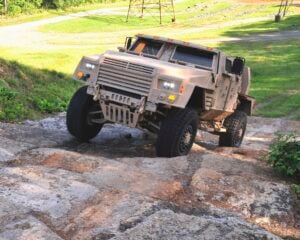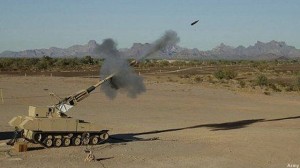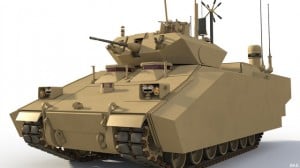Army To Congress: We Are Fixing Acquisition
Posted on

Army Secretary John McHugh (right)
WASHINGTON: The top question on defense lawmakers’ minds right now is: “Can we trust you with the people’s money?” And no large military organization has a worse record in that respect than the US Army, with its unhappy track record of canceled programs and wasted billions dating to before 9/11.
It’s such a sensitive and high-stakes question that, when I started to ask Army Secretary John McHugh about his service’s uphill battle to fix procurement, the normally mild-manned McHugh cut me off mid-question to deliver an impassioned defense.
“Whoa, whoa, whoa, whoa!” McHugh interrupted. “I’m very mindful of the spotty history of the United States Army on acquisition programs, but I do think, in fairness, we’ve got to say much of it is just that: history,” he said at a Defense Writers’ Group breakfast. “If you look at… current programs such as JLTV and AMPV that are on time, on budget, we’re doing much better.”

Lockheed Martin’s prototype JLTV
Does Congress agree? Well, one Hill staffer snarked, “if you’re not doing much, it should be easier to do what you are doing better.”
A second staffer was more positive. “JLTV and AMPV are looking good right now,” said a second Hill staffer. “Other programs…have had significant problems”: the Army’s helicopter development troubles, its digital radios, and its tactical wireless network for command and control, WIN-T. Overall, the staffer said, with little enthusiasm, “it is a mixed bag but moving in the right direction, I suppose.”
Secretary McHugh does have a case that things are better than they used to be during the ill-starred days of the Future Combat System, agreed experts I consulted on and off the Hill. But “better than FCS” is a low bar. What’s more, the experts said, the Army has — as the first staffer noted — reduced its problems with major modernization programs by not having many major modernization programs left.
McHugh cited the two largest surviving programs as Army successes. The Joint Light Tactical Vehicle will replace the vulnerable Humvee. The AMPV is the Armored Multi-Purpose Vehicle to replace the Vietnam-vintage M113 “battle taxi.” But both these programs are much less ambitious than FCS, the cancelled Ground Combat Vehicle, or the stillborn Armed Aerial Scout. Meanwhile, Army plans for future fighting vehicles remain modest conceptual and research efforts, not funded development programs.
“The Army has made progress in fixing its acquisition problems,” said Loren Thompson, a defense industry consultant, “but they’re walking away from most of their modernization plan.”

The cancelled FCS artillery vehicle
Small Victories
The current star of the Army acquisition show is, arguably, JLTV. “It’s meeting all its requirements, there’s three very good variants to choose from, and the contract will be awarded on time in July,” Thompson told me.
But that one word, “light,” speaks volumes: JLTV is essentially an armored truck. Admittedly, it’s a truck that must combine the mobility of the old, unarmored Humvee with the heavy, lumbering MRAPs. That’s a difficult design challenge, but not on the scale of a new tank or combat helicopter.
Even so, JLTV originally struggled until the Army — with a big assist from the Marines — reined in its original ambitions and accepted more realistic performance requirements. The Marine Corps is not only purchasing 5,000 JLTVs, about a tenth of the Army buy, but it also provides the deputy program director and offers a lot of experience living within small budgets.
With the program reorganized and more realistic, JLTV moved ahead. Lockheed Martin, Oshkosh, and AM General have built 22 prototypes apiece and the Army will choose a winner in July.
By contrast, the contract to develop the Armored Multi-Purpose Vehicle was just signed late last year, so we can’t really assess its success. What we do know is that BAE’s winning design is essentially a stripped-down version of the long-serving M2 Bradley troop carrier, with the turret and heavy weaponry removed.
“AMPV is on a good track, but it tells you where the Army is in fiscal terms that buying modified Bradleys is a ‘modernization’ initiative,” Thompson, a member of the Breaking Defense Board of Contributors, told me.
That said, the turretless Bradley is definitely an improvement over the thinly armored M113. Bradleys were sometimes blown up by roadside bombs in Iraq, but M113s were so vulnerable they were rarely allowed off base. “The M113 is obsolete. I mean, it’s a danger to our soldiers,” Lt. Gen. H.R. McMaster told an earlier Defense Writers’ Group. “So we want to accelerate the Armored Multi-Purpose Vehicle.”
AMPV probably is executable on time and under budget, Thompson said — but that’s largely because — like all the Army’s efforts right now — it’s so modest.

BAE’s design for the cancelled Ground Combat Vehicle
Ambitions In Armor
Compare AMPV to the Army’s previous top-priority armored vehicle program, the Ground Combat Vehicle (GCV). While AMPV is a stripped-down Bradley to replace M113s in various support roles — mobile command post, armored ambulance, supply, and so on — GCV would have been a frontline combat vehicle to replace the Bradley. In fact, it would have looked like the Bradley’s big brother, carrying more troops with better protection. As a result, even after the Army radically trimmed requirements, the GCV designs weighed in at 56 to 70 tons, depending on the armor kit installed, compared to 35 to 40 tons for the Bradley.
The Army cancelled GCV last year — but Army officials insist it was purely the result of budget pressures, not any problem with the program.
“Whoa,” Sec. McHugh said when I cited GCV in a list of failed programs. “Crusader I’ll give you. I’ll give you FCS. I’ll give you Comanche. I’ll give you a lot of things, but I won’t give you Ground Combat Vehicle… That program was on time. It was on budget; and we ended the contract at the technology and development phase almost exclusively because the budget required us, regrettably, to do so.”
The view from Capitol Hill’s a little different. “Weight, driven by requirements, did in GCV,” the former Hill staffer told me.
“Despite what some in the Army claim, the problem with GCV was the requirements,” agreed a current Hill staffer (the one we quoted above calling Army acquisition “a mixed bag”). “[Requirements like] ‘carry nine soldiers… impregnable from 360 degrees…lethal at extended ranges.’ As a result, the designs were going to be huge and expensive.”
(Arguably, modern urban warfare requires a heavily armored infantry carrier like GCV: look at Israel’s 49-ton Achzarit and 66-ton Namer.)
“The ‘costs too much’ aspect to GCV was a direct result of out-of-control requirements,” the Hill staffer said. “In contrast, for the three potential new vehicles McMaster is looking at, they are taking a much more thoughtful approach and appear to be willing to accept risk in some areas to achieve critical capabilities in others. We’ll see.”
The “three vehicles” are all relatively light armored vehicles to support airborne troops and other light infantry: a troop transport to carry a squad; a light reconnaissance vehicle to scout ahead; and a Mobile Protected Firepower vehicle to take out tough targets, basically a light tank. A more heavily armored Future Fighting Vehicle to replace the Bradley remains a research project, still far from the requirements stage.
McMaster is Lt. Gen. H.R. McMaster, the deputy chief of staff for “futures” at the Army’s powerful Training and Doctrine Command. It’s TRADOC that writes the infamously flawed requirements, and both McMaster and his commander Gen. David Perkins have promised to reform the process. The three pillars of their approach: wider consultation across the Army; a constant eye on cost; and a realistic appreciation of what technology can and cannot do.
“If it were anyone other than McMaster, I would be skeptical,” said the former Hill staffer, but McMaster has tremendous street cred inside and outside the Army.

Lt. Gen. H.R. McMaster
“We must inform the requirements based on a rigorous understanding of what kind of technology applies,” McMaster said. That means avoiding the overreaching ambitious of past programs like the Future Combat System. It also means not expecting technical miracles. New armor materials may save some weight, but to keep the size of the next troop carrier under control, TRADOC may also have to rein in its requirements, he said: “It may carry a fire team” — i.e. four or five men, like the Bradley — “instead of a squad” — of nine men, like the cancelled GCV.
“What H.R. is up to is both a big deal and long, long overdue,” the Hill staffer said. “TRADOC requirements have been significantly divorced from reality, in many cases, for a long time.”
Convincing Congress that Army requirements and its acquisition management have gotten more realistic will be a big part of this year’s budget battle on Capitol Hill.
Subscribe to our newsletter
Promotions, new products and sales. Directly to your inbox.
